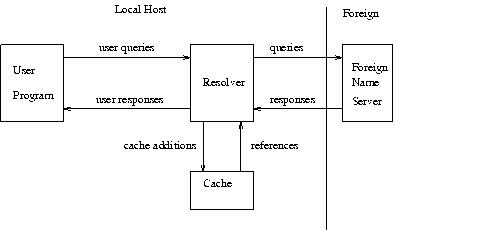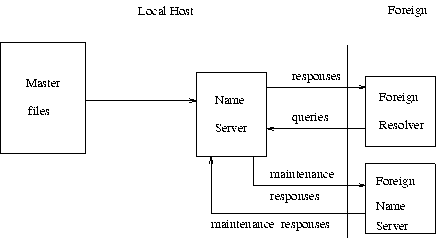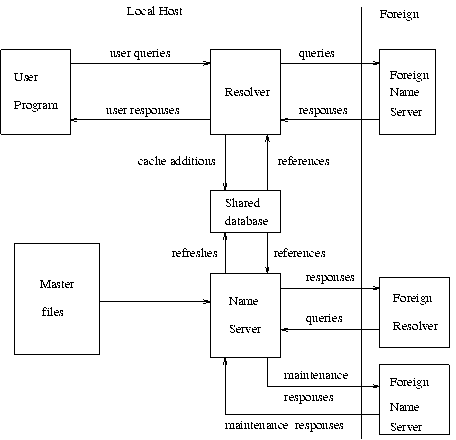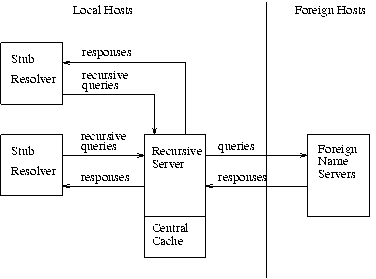
A host can participate in the domain name system in a number of ways, depending on whether the host runs programs that retrieve information from the domain system, name servers that answer queries from other hosts, or various combinations of both functions. The simplest, and perhaps most typical, configuration is shown below:

User programs interact with the domain name space through resolvers; the format of user queries and user responses is specific to the host and its operating system. User queries will typically be operating system calls, and the resolver and its cache will be part of the host operating system. Less capable hosts may choose to implement the resolver as a subroutine to be linked in with every program that needs its services. Resolvers answer user queries with information they acquire via queries to foreign name servers and the local cache.
Note that the resolver may have to make several queries to several different foreign name servers to answer a particular user query, and hence the resolution of a user query may involve several network accesses and an arbitrary amount of time. The queries to foreign name servers and the corresponding responses have a standard format described in this memo, and may be datagrams.
Depending on its capabilities, a name server could be a stand alone program on a dedicated machine or a process or processes on a large timeshared host. A simple configuration might be:

Here a primary name server acquires information about one or more zones by reading master files from its local file system, and answers queries about those zones that arrive from foreign resolvers.
The DNS requires that all zones be redundantly supported by more than one name server. Designated secondary servers can acquire zones and check for updates from the primary server using the zone transfer protocol of the DNS. This configuration is shown below:

In this configuration, the name server periodically establishes a virtual circuit to a foreign name server to acquire a copy of a zone or to check that an existing copy has not changed. The messages sent for these maintenance activities follow the same form as queries and responses, but the message sequences are somewhat different.
The information flow in a host that supports all aspects of the domain name system is shown below:

The shared database holds domain space data for the local name server and resolver. The contents of the shared database will typically be a mixture of authoritative data maintained by the periodic refresh operations of the name server and cached data from previous resolver requests. The structure of the domain data and the necessity for synchronization between name servers and resolvers imply the general characteristics of this database, but the actual format is up to the local implementor.
Information flow can also be tailored so that a group of hosts act together to optimize activities. Sometimes this is done to offload less capable hosts so that they do not have to implement a full resolver. This can be appropriate for PCs or hosts which want to minimize the amount of new network code which is required. This scheme can also allow a group of hosts can share a small number of caches rather than maintaining a large number of separate caches, on the premise that the centralized caches will have a higher hit ratio. In either case, resolvers are replaced with stub resolvers which act as front ends to resolvers located in a recursive server in one or more name servers known to perform that service:

In any case, note that domain components are always replicated for reliability whenever possible.